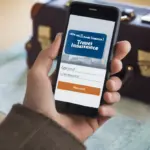Have you ever been in a foreign city, desperate to find the nearest Wi-Fi hotspot so you could navigate to your hotel or share that incredible sunset photo with your friends? We’ve all been there. In today’s hyper-connected world, staying online while traveling is no longer a luxury, it’s practically a necessity. But fear not, intrepid explorer! This guide will equip you with all the knowledge you need to easily access the internet on your next adventure.
Why You Need Wireless Internet While Traveling
Imagine you’re strolling down the charming streets of Florence, Italy. You’ve just finished indulging in the most delicious plate of pasta and are ready to explore the iconic Duomo. But wait, you need directions! This is just one scenario where having internet access on the go can be a lifesaver. Here are a few more:
- Navigation: Google Maps, Citymapper, and other navigation apps are essential for finding your way around unfamiliar places.
- Communication: Stay in touch with family and friends back home through messaging apps, video calls, or social media.
- Research: Quickly look up information about attractions, restaurants, transportation, or anything else you need on the fly.
- Safety and Emergencies: Access important travel documents, contact emergency services, or let loved ones know your whereabouts in unexpected situations.
Different Ways to Get Wireless Internet on Your Trip
1. International Roaming: Stay Connected with Your Home Network
Many mobile providers offer international roaming plans, allowing you to use your existing data and voice services while traveling abroad. This can be a convenient option for short trips or if you don’t plan on using a lot of data.
Pros:
- Easy setup – often just requires a call or online activation.
- No need for a new SIM card.
- Familiar billing process.
Cons:
- Can be very expensive, especially for data-intensive activities.
- Coverage may not be as reliable as local options.
Expert Tip: Before you go, contact your mobile provider to inquire about international roaming plans and rates to avoid any bill shock.
 woman navigating
woman navigating
2. Local SIM Cards: Tap into the Power of Local Networks
Purchasing a local SIM card at your destination is often the most cost-effective way to stay connected, especially for longer trips or if you plan on using a lot of data.
Pros:
- Generally much cheaper than international roaming.
- Usually offer faster data speeds.
- Gives you a local phone number, which can be useful for making reservations or contacting local businesses.
Cons:
- Requires unlocking your phone beforehand.
- May need to purchase a new SIM card for each country you visit.
- Your usual phone number will be temporarily unavailable (unless you have a dual-SIM phone).
Travel Tip: Many airports have kiosks or shops where you can purchase local SIM cards upon arrival. You’ll need to show your passport and sometimes provide a local address (your hotel address usually works).
3. Portable Wi-Fi Hotspots: Your Personal Wi-Fi Bubble
Portable Wi-Fi hotspots, also known as pocket Wi-Fi or MiFi devices, create a personal Wi-Fi network you can connect your devices to. They typically use cellular data to provide internet access.
Pros:
- Can connect multiple devices simultaneously (great for families or groups).
- Often more affordable than international roaming, especially for multiple devices.
- Offer greater security than public Wi-Fi networks.
Cons:
- Need to be charged regularly.
- Can be bulky to carry around.
- May require renting or purchasing the device in advance.
Did you know? Some travel bloggers recommend carrying a portable charger for your hotspot, ensuring you stay connected even on long days out.
4. Public Wi-Fi: Convenient but Use with Caution
Public Wi-Fi is widely available in many places, from cafes and restaurants to airports and hotels. It can be a great option for checking emails quickly or browsing the web, but it’s important to be aware of the risks.
Pros:
- Widely available and often free.
- Convenient for quick online tasks.
Cons:
- Security risks – public Wi-Fi networks are often unsecured, leaving your data vulnerable to hackers.
- Unreliable connections – speeds can vary greatly and connections can be unstable.
Expert Advice: “Always use a VPN (Virtual Private Network) when connecting to public Wi-Fi to encrypt your internet traffic and protect your sensitive information,” advises cybersecurity specialist, Anya Chen, author of “Staying Safe in a Connected World.”
 friends using wifi
friends using wifi
Planning for Internet Access: Tips for a Smooth Trip
Before you go:
- Unlock Your Phone: Make sure your phone is unlocked so you can use local SIM cards.
- Research Your Options: Compare international roaming plans, local SIM card providers, and portable Wi-Fi hotspot rental companies to find the best option for your needs and budget.
- Download Essential Apps: Download all the apps you’ll need offline maps, translation apps, and entertainment apps to avoid using data.
At Your Destination:
- Purchase a SIM card at the airport: This will allow you to get connected right away.
- Be mindful of data usage: Keep track of your data usage to avoid exceeding your limit and incurring extra charges.
- Look for Wi-Fi passwords: Don’t be afraid to ask for the Wi-Fi password at cafes, restaurants, or your accommodation.
Staying Connected While Respecting Local Customs
While access to information is important, it’s equally important to be present and respectful of the local culture. Put the phone down, engage with locals, savor the food, and soak in the beauty of your surroundings.
Have a Question About Staying Connected on Your Next Trip?
We hope this guide has been helpful! If you have any questions or need more personalized advice, feel free to reach out to the travel experts at TRAVELCAR.edu.vn. We’re here to help you make the most of your journey.


